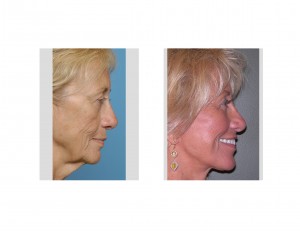
Because a facelift only treats the sag in the skin and underlying tissues due to effects of gravity and other environmental factors, additional skin issues such as finer wrinkles, brown spots, large pores, red spots and generalized poor skin texture are not treated. Simply lifting up and pulling the skin tight will not get rid of every facial imperfection. Undergoing skin treatments both before and after a facelift can really put the ‘icing’ on the effects of the surgery.
Treatment options before a facelift can include microdermabrasion combined with light chemical peels (what I call a medical microdermabrasion) or medium-depth chemical peels like a Vi peel or the Perfect peel. These should be done no sooner than three or four weeks before surgery. These skin treatments will really freshen up the skin and an immediate improvement in skin texture will be seen.
In addition, the use of Retin-A is a great topical daily treatment in addition to or in lieu of the patient’s existing skin care regimen. While Retin-A has been around for decades and is not a sexy new topical agent, its benefits to the skin are well proven. It makes the skin healthier by thickening the dermis and improving its vascularity. This makes it heal better after surgery or just skin resurfacing. The strength of the cream or gel and how many times to apply it daily depends on the patient’s skin. The thicker the skin, the greater strength and number of applications it will tolerate without becoming too irritated.
After facelift skin care initially can include oral and topical Arnica and mineral makeup to cover the bruising. A return to one’s normal skin care regimens should wait a few weeks after surgery until the bruising is gone and most of the swelling has subsided. A month to six weeks after a facelift is a good time to have a microdermabrasion treatment to exfoliate the skin and buff up the facelift result. While there are many skin care product lines available, the use of topical Retin-A at some frequency of application after a facelift is always a good product to incorporate into one’s skin care regimen.
For many facelift patients, this surgery may be done only once in their lifetime. Many of these patients have never had a good skin care regimen and this surgery provides an opportunity to embark on one. Helping the facelift patient enhance and protect their surgery efforts is a valuable educational service.
Dr. Barry Eppley
Indianapolis, Indiana


